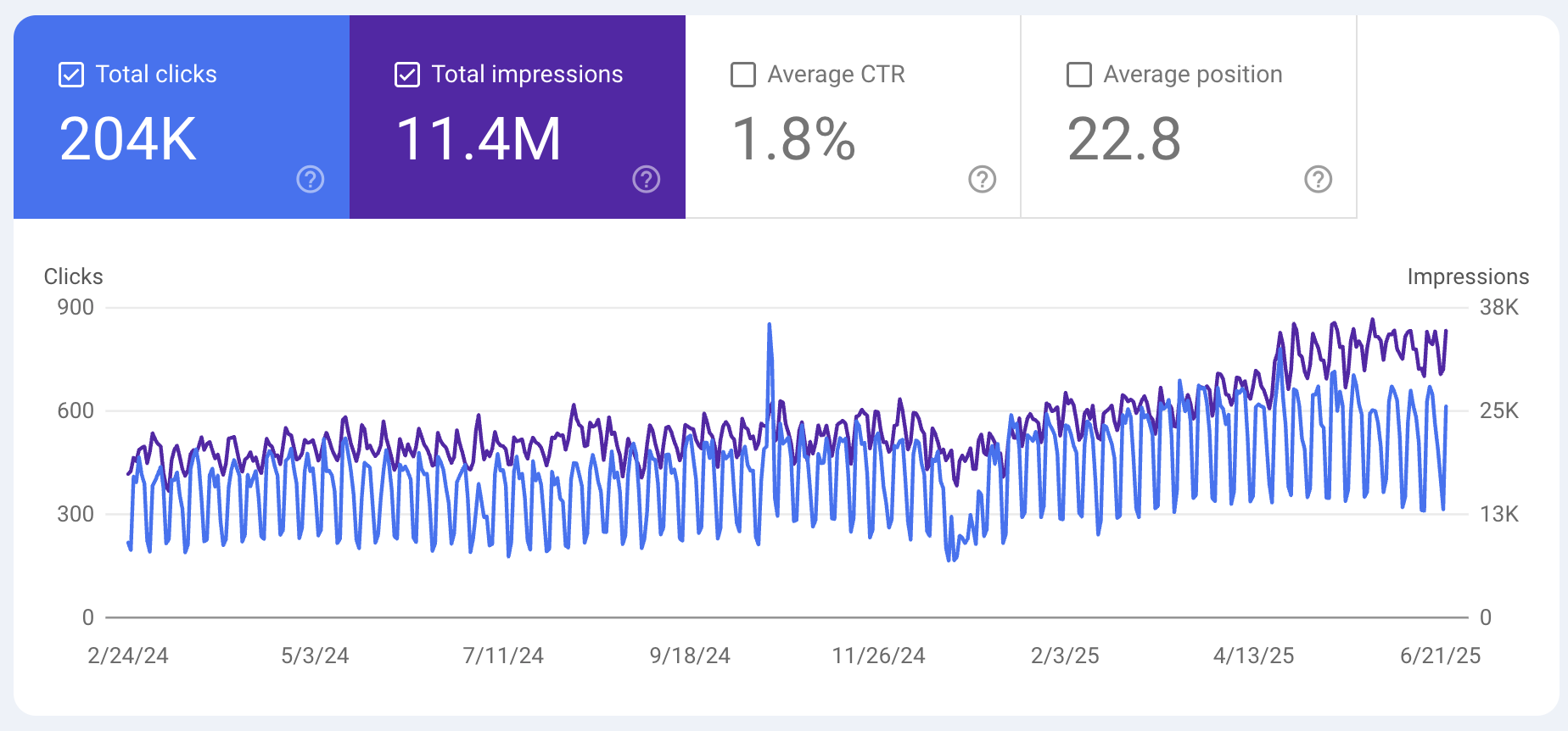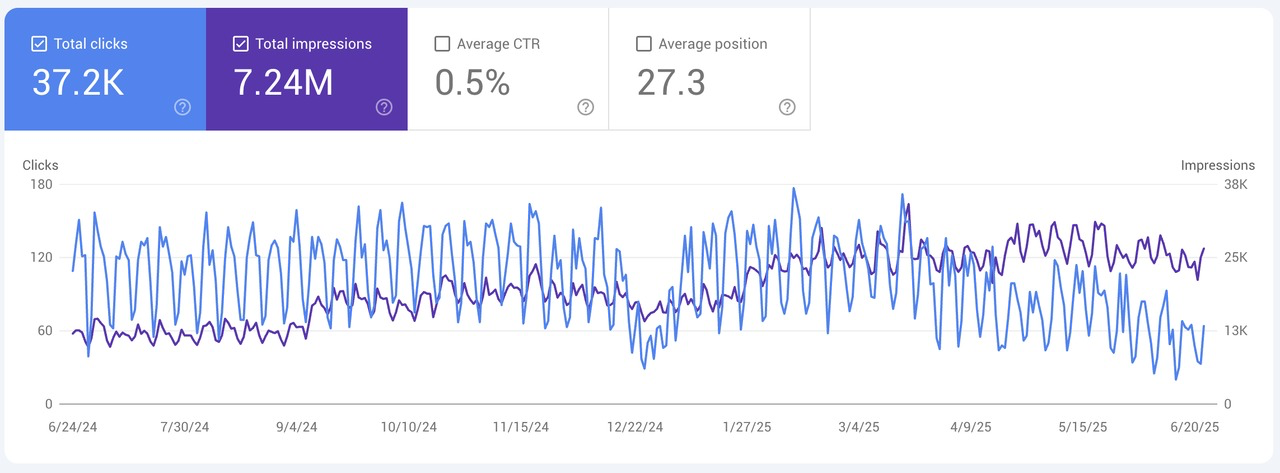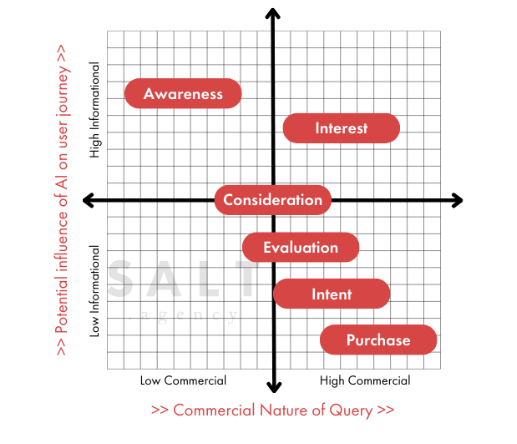Something important is happening in Google Search.
If you’ve looked at your website data in Google Search Console, you may have noticed something odd. Your pages are showing up more often, but fewer people are clicking through.
These two signals – impressions and clicks – are used to rise and fall together. Now, they’re drifting apart.
We call this “The Great Decoupling.”

And it’s not just your business. This is happening across industries and most website types.
It became more noticeable as Google rolled out something called AI Overviews – automated summaries that answer questions directly in search results.
If your site traffic from search is falling, but your rankings look fine, this article will help explain why.
We’ll examine the changes, their causes, how they manifest in analytics tools, and the responses of leading companies.
What’s Happening And Why It Matters
The Great Decoupling describes a new disconnect. Your website can appear more often in search results but get fewer clicks.
That was only “the expected behavior” when the SERP had things like featured snippets, or other special content result blocks from Google.
We’ve seen this clearly in client data during the first half of 2025.
 Screenshot from Itamar Bauer (with permission to use), Studio Hawk, June 2025
Screenshot from Itamar Bauer (with permission to use), Studio Hawk, June 2025Near the end of 2024, impressions and clicks were still closely linked. But by early 2025, impressions kept going up while clicks went down.
The click-through rate, the percentage of people who click, dropped sharply.
This trend is widespread. Whether your site is an ecommerce store, a B2B company, or a blog, the same thing is happening – more visibility but less engagement.
Martin Splitt has said that when your pages are shown in AI Overviews, you may get more impressions but fewer clicks.
He also said that people might still convert later, perhaps after seeing your brand in search results, even if they never click the first time.
So, we’re in a new “normal”; impressions alone no longer signal opportunity. It’s what happens after the impression that counts.
Why This Is Happening
Google’s move toward AI-powered results is driving this change. The most significant shift is the introduction of AI Overviews.
AI Overviews are summaries shown at the top of search results.
Instead of a list of websites, Google provides an instant answer. That answer is generated from various sources across the web, including yours, without requiring the user to click.
Your Content May Appear Twice, But It Only Gets One Chance To Earn A Click
Your site may show up as both a traditional link and as part of the AI Overview. That boosts impressions but often reduces clicks. People get what they need from the overview.
Less Friction Means Fewer Visits
The AI Overview gives users what they want quickly. However, if their need is met before they reach your site, your traffic will drop.
Some Search Terms Are Hit Harder Than Others
Generic questions, how-tos, and mid-funnel queries are more likely to trigger AI Overviews. These are often top-of-funnel keywords marketers use to drive discovery.
On the other hand, brand searches and high-intent queries are more resilient.
The point is that it’s not just about where you rank. It’s about whether Google decides to answer the question for the user without needing you.
Zero-Click Search Isn’t New
This isn’t entirely new. For years, Google has provided users with quick answers. Featured snippets, “People Also Ask” boxes, and knowledge panels all reduced the need to click.
AI Overviews are just the next step. They are more advanced, appear more often, and answer a broader range of questions. But, the principle is the same: to reduce the effort for the user.
We’ve adapted before. We can adapt again. However, this shift is more significant and impacts multiple stages of the customer journey, necessitating a more strategic approach.
What This Looks Like In Your Analytics
In Google Search Console, the gap between impressions and clicks is clear. In Google Analytics 4, you see the impact on your traffic and behavior metrics.
Organic Traffic Is Falling
Your GA4 report shows fewer sessions from Google, even though your rankings haven’t changed. That’s the result of fewer clicks.
Engagement May Look Better
Because fewer but more qualified visitors are reaching your site, session length and conversion rates may look stronger. But, overall, reach is down.
Attribution Becomes Less Clear
GA4 does not show traffic that came through AI Overviews separately.
Some visitors might return later and be counted as “direct” traffic. Others won’t be tracked at all. This makes it more challenging to attribute SEO’s role in brand discovery.
To understand what’s happening, you need to look at GSC and GA4 together. One shows the visibility. The other shows the outcomes.
How I Think You Should Adjust & Act
The most forward-thinking businesses are making strategic shifts to protect and grow their visibility. Here are four things they’re doing:
1. Strengthen Brand
When users search for you by name, Google is less likely to intervene. These clicks are holding steady and, in some cases, growing.
Investing in brand and trust is generic advice being thrown around a lot at the moment, but I think you should be looking at your brand in consideration of a user journey and what scope AI platforms have to alter that user journey before your brand is discovered.
 Image from author, June 2025
Image from author, June 2025This also means working to understand how well-known your brand is before a user starts at the “top of the funnel,” and whether or not they’re more likely to steer towards your brand due to previous positive brand touchpoints, or the sentiment and user stories of others online.
2. Publish Content That AI Can’t Copy
If your content is generic, Google’s AI can summarize it. If it’s unique, based on experience, data, or opinion, it’s much harder to replace.
Focus on:
- Original research.
- Customer stories.
- Side-by-side product comparisons.
- Tools and calculators.
- Real customer feedback.
3. Build Around Topics, Not Keywords
Create clusters of related content around a theme. This signals authority to search engines and gives users more reasons to explore your site.
4. Turn Product Pages Into Useful Resources
Don’t just list specs. Add real information that helps the buyer:
- FAQs.
- Reviews.
- Comparison tables.
- Guides and videos.
You want to help the buyer better forecast their experience with the product or service, as well as their understanding of your brand.
Be upfront about as much information as possible, as a negative brand or product experience can be damaging in the long run.
Why SEO Still Matters
Yes, SEO remains highly relevant despite the rise of AI.
While AI tools are changing how search works and how users find answers, they haven’t replaced the need for a smart, well-executed SEO strategy.
SEO is evolving and becoming more important in new ways.
AI Needs High-Quality Content To Learn From
AI Overviews don’t invent answers. They draw from trusted online sources. That means Google still relies on high-quality, well-optimized content to build its responses.
SEO helps ensure your content meets the standards of E-E-A-T: experience, expertise, authoritativeness, and trustworthiness.
Search Engines Still Rank Pages
Even with AI features in search results, users still scroll through traditional listings and click on websites.
SEO ensures your content performs well in these results, whether it’s in the top 10 links, a featured snippet, or a “People Also Ask” box.
AI Enhances, Not Replaces, SEO
AI tools can automate certain aspects of SEO, such as keyword research and content suggestions. But, they don’t replace strategic thinking.
SEO experts continue to guide site architecture, content structure, technical fixes, and intent-based optimization – tasks that AI can’t fully handle alone.
SEO isn’t going away; it’s becoming more sophisticated.
The businesses that succeed will be the ones that blend innovative tools with strategic thinking and treat SEO as a long-term investment in visibility and value.
The new wave of SEO isn’t just about driving traffic. It’s about showing up where your customers are asking questions, building credibility, and creating a footprint that supports all your other channels.
- Visibility builds trust. Even if someone doesn’t click, seeing your name in search results reinforces brand awareness.
- SEO feeds other channels. The insights you gain from search, what people ask, how they ask it, and what ranking help shape your messaging everywhere else.
- Strong content earns attention. Helpful, original content can drive engagement on-site, across social media, and in sales conversations.
- It remains one of the most cost-effective ways to acquire leads, especially for branded and high-intent queries.
Search may not deliver the same volume of clicks, but it still shapes perception, influence, and decision-making.
SEO remains one of the most effective ways to stay visible and valuable in an increasingly AI-driven world.
Change What You Measure
The Great Decoupling is not just an SEO story. It’s a business visibility story. More people may see your brand, but fewer will visit your site.
That means you can’t just measure success by traffic. You need to consider engagement, recall, and brand strength.
Search is becoming a reputation game. If people trust you, they’ll find you, even if they don’t click the first time.
The companies that win won’t be the ones who chase rankings; they’ll be the ones who earn attention. Attention is potentially the “new click.”
More Resources:
Featured Image: Master1305/Shutterstock
